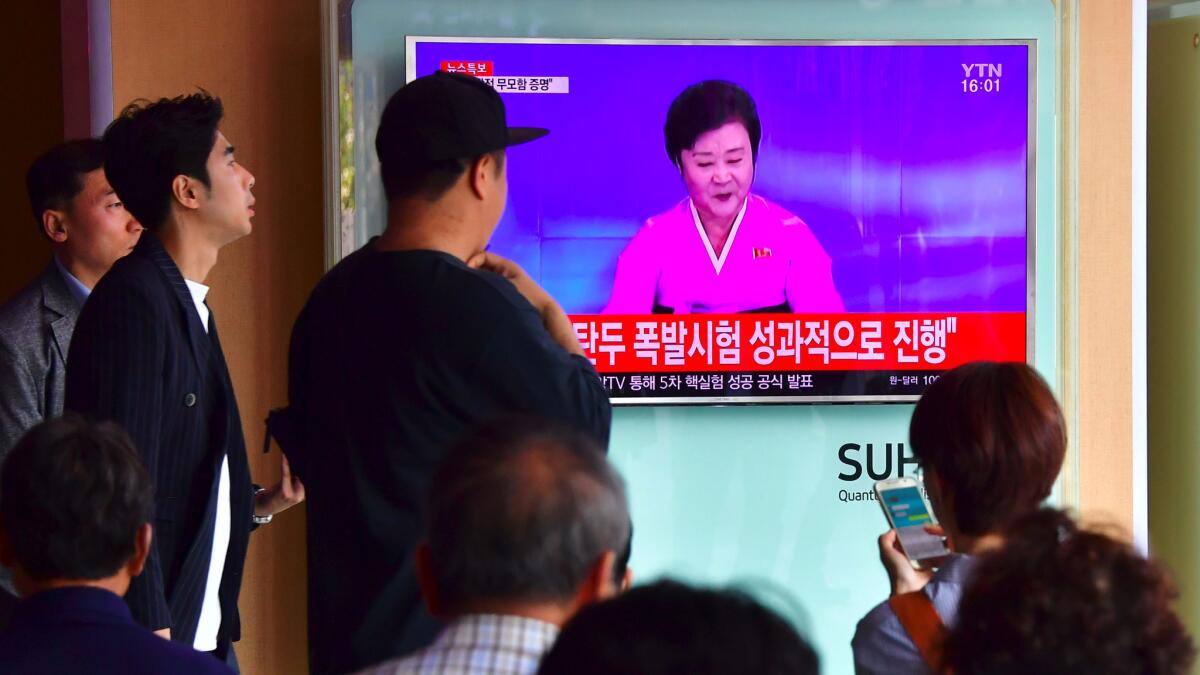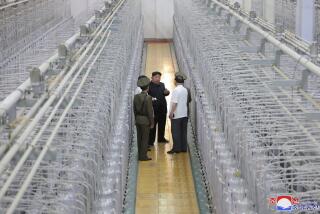North Korea’s latest nuclear test could be a key step in its weapons program

- Share via
Reporting from Washington — Tremors that emanated Friday from North Korea’s northeastern nuclear test site alerted the world to another crucial step that the isolated nation had made in its defiant, decade-long march to develop long-range missiles tipped with lightweight nuclear warheads.
The man-made earthquake, detected by U.S. instruments Friday at 5.3 in magnitude, was more powerful than any of the previous underground tests conducted by the government of North Korean leader Kim Jong Un — indicating that the weapon detonated with a yield of about 10 kilotons.
The test, when coupled with the three successful ballistic missile launches earlier in the week, offered a hint to world leaders that North Korean engineers and scientists are making another incremental, yet significant, step in their nuclear weapons program.
Two of the nation’s five successful nuclear detonations have occurred in the last eight months. Over that same period, the military has launched an unprecedented 21 ballistic missile launches — more than four times as many as North Korea had ever fired previously.
State-run media in the capital of Pyongyang made a number of assertions Friday, saying North Korea had become a full-fledged nuclear weapons state, had a standardized weapon design and now possessed warheads small enough to be affixed to ballistic missiles. It characterized the Friday tests as a “higher-level” nuclear warhead explosion that would prepare the country to retaliate against any “provocation” by “U.S.-led hostile forces.”
The test drew condemnation from across Asia and exacerbated fears that the communist country, derisively nicknamed the “Hermit Kingdom,” is steadily making progress toward its goal of developing the technology to unleash a nuclear strike on the U.S.
The apparent advancements have come despite a range of United Nations sanctions that have ground the North Korean economy to a halt. The U.N. Security Council convened an emergency meeting Friday in New York.
President Obama issued a statement promising “additional significant steps,” including further sanctions, against the rogue state.
“Far from achieving its stated national security and economic development goals, North Korea’s provocative and destabilizing actions have instead served to isolate and impoverish its people through its relentless pursuit of nuclear weapons and ballistic missile capabilities,” Obama said.
American defense officials expressed concern Friday that the tests demonstrate a new level of sophistication, though non-government experts in the U.S. are still hungering for evidence or formal analyses of where North Korean technology and industrial capability stand.
Joel Wit, a founder of the 38north.org website affiliated with Johns Hopkins University, said North Korea almost certainly has achieved a capability to place a nuclear weapon on a regional ballistic missile that could threaten South Korea, Japan, China or Russia, as well as U.S. bases in the region, where tens of thousands of American troops are deployed.
The most recent tests could signify that the nation is making new technological strides, he said — or, alternatively, that its programs are only now reaching a stage when more testing is necessary, or that Kim is conducting propaganda stunts.
“It is a nuanced picture,” he said. “People are jumping to conclusions that the tests mean there is a big acceleration and that may not be the case.”
To be sure, the nuclear device developed by North Korea is rudimentary by U.S. standards. South Korea’s military said the early indication is that North Korea’s test created a blast of 10 kilotons in yield, which is less than the atomic bomb that the U.S. dropped on Hiroshima in World War II.
Pyongyang was able to develop a bomb ready for testing just eight months after its previous detonation in January. But clearly North Korea has not reached the level of sophistication of Pakistan or India, which each detonated five nuclear weapons on a single day in 1998 and now have stockpiles estimated by the Federation of American Scientists of about 120 warheads.
“Two detonations would burn six to 10 kilograms of plutonium, depending on how sophisticated the device was,” said Hans Kristensen, a federation nuclear weapons expert. “They have enough capability to do that.”
But Kristensen said what is missing is an open U.S. intelligence estimate of North Korea’s program. “The statements we have heard are contradictory.”
An exhaustive investigation by military and intelligence agencies into the test to confirm the size of the detonation, the type of radioactive fuel it used, how the fuel was produced and the sophistication of its design, will take weeks. The rebuke for the test, however, was immediate.
Even China, North Korea’s only real ally, which has customarily used its diplomatic sway to shield North Korea from punishment, issued a statement condemning the detonation.
Zhang Liangui, a North Korea expert at the Central Party School of the Communist Party of China, said Beijing would likely adopt any new sanctions that the U.N. decided to take against North Korea following the test.
“This is a critical moment to solve the crisis on the Korean Peninsula, so [I predict] the U.N. will adopt tougher sanctions against North Korea than ever before,” he said. “I think China will take more effective methods to carry out the sanction.”
The frequent, unannounced missile launches by North Korea, prompted Washington to announce plans in July to deploy a U.S. antiballistic missile system in South Korea. China, however, protested that the system would undermine its own nuclear deterrent, a reaction that shows how North Korea’s program is exacerbating tensions in the region.
U.S. Strategic Command tracked the unprecedented 21 missile launches so far this year, including North Korea’s first successful launch of a missile from a submarine, after spotting them on U.S. early warning satellites and radar systems that ring the Pacific.
The military has determined that the missiles were launched from North Korea but have not yet posed a threat to North America. But that assurance provides scant comfort at a time when North Korea has stepped up the pace of both missile and nuclear weapons testing, fueling growing concern in the U.S., Japan and South Korea
North Korea has steadily built its own base of missile technology, allowing it to launch a satellite into orbit in 2012. A Defense Department report to Congress last year described nine major North Korean ballistic missiles, including three versions of old Soviet Scuds that represent its largest force. The Scud, used by Iraq to terrorize Israel during the Persian Gulf War, has a range of up to 600 miles, long enough to reach anywhere in South Korea and most of Japan.
The latest tests involve road-mobile missiles that are hard to track, which could extend North Korea’s range to 2,000 miles, easily encompassing Japan, South Korea and a broad swath of China.
North Korea is developing a three-stage missile, dubbed the Hwasong-13 or KN-08. The system has an estimated range of more than 3,400 miles, roughly the distance from North Korea to Anchorage, making it a legitimate intercontinental ballistic missile, according to the Pentagon report to Congress.
Hennigan reported from Washington and Vartabedian from Los Angeles. Times staff writers Jonathan Kaiman in Beijing and Michael A. Memoli in Washington contributed to this report.
ALSO
Obama calls North Korea’s latest nuclear test a ‘grave threat’ to international stability
North Korea’s ‘higher-level’ nuclear test explosion sets the region on edge
Obama vows to tighten sanctions on North Korea after missile launch
More to Read
Sign up for Essential California
The most important California stories and recommendations in your inbox every morning.
You may occasionally receive promotional content from the Los Angeles Times.












